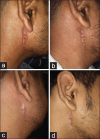Comparative Evaluation of the Aesthetic Outcomes of Octyl-2-Cyanoacrylate Skin Adhesive and Ethilon Suture in Maxillofacial Surgery - A Randomised Clinical Study
- PMID: 39184421
- PMCID: PMC11340837
- DOI: 10.4103/ams.ams_182_23
Comparative Evaluation of the Aesthetic Outcomes of Octyl-2-Cyanoacrylate Skin Adhesive and Ethilon Suture in Maxillofacial Surgery - A Randomised Clinical Study
Abstract
Introduction: Wound closure methods have evolved, attributed to the armamentarium including the synthetic sutures, staples, surgical adhesive tapes and, most recently, the cyanoacrylate tissue adhesives. Cyanoacrylates have shown promising results in terms of aesthetic outcomes in other fields of surgery. The aim of this study is to compare the aesthetic value of Dermabond over Ethilon suture when used in case of facial surgical incisions. The purpose of this study was to demonstrate the efficacy of Dermabond for wound closure in the head-and-neck region.
Materials and methods: This study involved 20 subjects undergoing maxillofacial surgery. In 10 subjects, skin closure was done with conventional suturing (Ethilon) and other 10 subjects with tissue glue (2-octyl cyanoacrylate). Observations regarding skin closure time and scar assessment were made, and their results were compared.
Results: The mean time for closure in the Dermabond group was 217.2 ± 42.0 s and for Ethilon suture group was 383.3 ± 140.2 s. Dermabond was significantly better than Ethilon sutures at both 1 month and 3 months with P = 0.001 and P < 0.001, respectively. For Dermabond, the average score improved from 8.2 ± 2.5 at 1 month to 6.1 ± 1.6 at the 3rd month. The improvement was statistically significant (P = 0.001) for Ethilon sutures; the average score improved from 12.0 ± 1.2 at 1 month to 10.2 ± 2.0 at 3rd month. The improvement was statistically significant (P = 0.038).
Discussion: Adhesive glue appears to be superior to conventional suturing in clean elective surgeries. It is a safe and effective method of skin closure with less operative time and better cosmesis of the scar.
Keywords: Cyanoacrylates; octyl-2-cyanoacrylate; surgical incisions; suture; tissue adhesives.
Copyright: © 2024 Annals of Maxillofacial Surgery.
Conflict of interest statement
There are no conflicts of interest.
Figures





References
-
- Dinakar D, Ellur S, Joseph VA. randomized trial comparing octyl cyanoacrylate tissue adhesive and sutures in the management of facial lacerations. Eur J Plast Surg. 2019;42:597–602.
-
- Singer AJ, Thode HC., Jr A review of the literature on octylcyanoacrylate tissue adhesive. Am J Surg. 2004;187:238–48. - PubMed
-
- Castañón García-Alix M, Sancho Vendrell MA, Parri Ferrandis FJ, San Vicente Vela B, García Aparicio L, Tarrado Castellarnau X, et al. Utility of octyl 2-cyanoacrylate in pediatric surgery. An Pediatr (Barc) 2003;59:548–51. - PubMed
-
- McMullen KP, Harris MS, Dodson EE. Use of 2-Octyl cyanoacrylate in cartilage interposition adherence during ossiculoplasty. Laryngoscope. 2017;127:731–4. - PubMed
LinkOut - more resources
Full Text Sources
Miscellaneous
